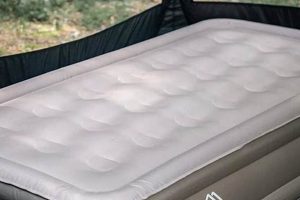The maximum weight capacity of an inflatable sleeping surface refers to the specified load it can safely support during use. Exceeding this designated value can result in damage to the product, compromised structural integrity, and potential failure of the air bladder. For example, a double-sized model might indicate a maximum supportable mass of 500 pounds; using it with a load greater than that amount risks material stress and deflation.
Adhering to the suggested capacity is crucial for ensuring user safety, prolonging the lifespan of the inflatable bed, and maintaining consistent comfort levels. Historically, limitations have been primarily constrained by the materials used in construction, such as PVC or reinforced plastics. Modern manufacturing advancements are constantly seeking to improve this factor through stronger, more resilient material compositions.
Understanding the significance of adhering to these specifications is vital. The following sections will delve into factors influencing this particular characteristic, how to determine the appropriate model for individual needs, and best practices for maintaining optimal performance and longevity.
Adhering to Inflatable Bed Capacity
The following guidelines promote safe and effective use of inflatable sleeping surfaces, primarily concerning its specified load-bearing limits.
Tip 1: Consult Product Specifications. Always examine the manufacturer’s documentation, either included with the product or available online, for the exact load-bearing rating. This information is critical for safe operation.
Tip 2: Account for Dynamic Load. The stated capacity typically refers to static weight. Movement, such as sitting up or shifting position, can briefly increase the pressure on the air bladder. Select a model with a higher rating if dynamic use is anticipated.
Tip 3: Distribute Weight Evenly. Concentrated pressure in a single area increases the likelihood of failure. Ensure the load is spread across the entire surface to avoid undue stress on any particular point.
Tip 4: Avoid Sharp Objects. Placement on uneven surfaces containing sharp objects can compromise structural integrity, even if the load is within acceptable ranges. Clear the area before inflation.
Tip 5: Monitor for Air Leaks. Periodic inspection for leaks is vital. Even minor air loss can affect the rigidity and load-bearing capability, leading to potential collapse under load.
Tip 6: Consider Intended Use. If the inflatable bed will be utilized by multiple individuals, especially if their combined mass approaches the rated limit, opt for a heavier-duty model designed for higher loads.
Tip 7: Temperature Considerations. Extreme temperatures can affect the material’s elasticity. Avoid exceeding the product’s limitations when exposed to very hot or very cold environments.
Following these directives will help ensure safe operation, prolong the lifespan of the inflatable sleeping surface, and prevent unexpected failures related to exceeding the designated supportable mass.
The subsequent section will address factors related to material composition and construction affecting its overall durability.
1. Material Strength
Material strength is a foundational element directly influencing the maximum load an inflatable mattress can safely support. The composition and structural characteristics of the material define its resistance to deformation and potential failure under stress. Therefore, material selection is paramount in determining the capabilities of inflatable beds.
- Tensile Strength and Tear Resistance
Tensile strength refers to the maximum stress the material can withstand while being stretched or pulled before breaking. Tear resistance, similarly, quantifies the material’s ability to resist tearing when subjected to concentrated stress. Higher values in both metrics translate to a greater capacity to bear heavy loads without compromising structural integrity. For instance, a mattress constructed from reinforced PVC with high tensile strength is less likely to rupture under significant weight compared to a similar mattress made from standard PVC.
- Material Elasticity and Plasticity
Elasticity describes the material’s ability to return to its original shape after the removal of a deforming force, while plasticity refers to the material’s tendency to permanently deform under stress. In the context of inflatable mattresses, a material with high elasticity can withstand temporary overloads without permanent damage, whereas a material with high plasticity may stretch or deform under prolonged pressure, reducing its ability to support the specified load over time. Thermoplastic polyurethanes (TPUs) are often preferred for their favorable elasticity and resistance to permanent deformation.
- Seam Strength and Welding Techniques
Even if the material itself possesses high strength, the seams joining different sections of the mattress remain a potential point of failure. The welding techniques used to create these seams significantly impact their ability to withstand pressure and stress. Radio frequency (RF) welding, for example, creates a strong, airtight bond that is more resistant to separation under load compared to simpler adhesive methods. The integrity of the seams directly influences the overall capacity of the inflatable bed.
- Resistance to Creep and Fatigue
Creep is the tendency of a material to deform slowly over time under constant stress, while fatigue refers to the weakening of a material caused by repeated cycles of loading and unloading. An inflatable mattress experiences both phenomena during normal use. Materials with high resistance to creep and fatigue will maintain their structural integrity and load-bearing capacity for a longer duration. Polyethylene terephthalate (PET) fabrics are often incorporated into high-end mattresses to improve resistance to these effects.
The interplay between tensile strength, elasticity, seam construction, and resistance to creep defines the overall material strength and, consequently, sets the fundamental load-bearing capability of any inflatable mattress. Selecting models constructed from materials with demonstrably superior performance in these areas is crucial for ensuring user safety and product longevity, and it provides clarity in considering the stated maximum supportable mass.
2. Inflation Pressure
Inflation pressure within an inflatable mattress directly influences its ability to support a specified load. Optimal inflation provides the necessary structural rigidity to distribute weight effectively, while deviations from the recommended pressure range can compromise both comfort and load-bearing capacity. Therefore, adherence to manufacturer-speci
fied inflation guidelines is crucial for safe and effective use.
- Relationship to Internal Stress
Increasing the inflation pressure raises the tensile stress on the mattress material and its seams. While higher pressure can enhance support up to a point, exceeding the recommended level increases the risk of material failure, particularly at stress concentration points. Conversely, insufficient inflation results in reduced support and an increased risk of bottoming out under load, potentially damaging the mattress or causing discomfort.
- Impact on Surface Area and Weight Distribution
The degree of inflation affects the overall surface area in contact with the supporting structure (e.g., floor). A properly inflated mattress distributes weight more evenly across its surface, minimizing stress on any single point. Under-inflation leads to a smaller contact area, concentrating the load and potentially exceeding the material’s local capacity. Over-inflation, while increasing the contact area, can create excessive rigidity that compromises comfort and increases susceptibility to punctures from sharp objects.
- Influence of Temperature Variations
Air pressure within a sealed volume, such as an inflatable mattress, is sensitive to temperature fluctuations. A decrease in temperature reduces the internal pressure, potentially leading to under-inflation and diminished support. Conversely, an increase in temperature raises the pressure, increasing stress on the material. It is therefore important to monitor and adjust the inflation level based on environmental conditions to maintain optimal support and avoid over-pressurization.
- Calibration and Pressure Monitoring
Accurate pressure measurement is essential for maintaining the appropriate inflation level. Integrated pressure gauges or external pressure monitors provide valuable feedback, enabling users to adjust the inflation to match the manufacturer’s recommendations and compensate for environmental changes. Consistent monitoring ensures that the mattress operates within its safe and optimal performance range.
The interplay between inflation pressure, material stress, weight distribution, and environmental factors underscores the critical role of maintaining proper inflation. Deviations can significantly affect the maximum load the mattress can safely handle, potentially resulting in discomfort, damage, or even failure. Therefore, diligent monitoring and adjustment of pressure in accordance with the manufacturer’s guidelines are crucial to ensuring both user safety and product longevity when considering weight limitations.
3. Internal Baffles
Internal baffles are structural components within air mattresses designed to enhance stability, distribute weight evenly, and prevent localized deformation. Their configuration and material properties directly influence the mattress’s ability to support a specified load. The presence and design of these baffles play a critical role in determining the overall supportable mass.
- Load Distribution and Support Uniformity
Baffles function as internal supports that prevent air from shifting excessively within the mattress. This compartmentalization ensures that weight is distributed more evenly across the surface, reducing stress concentration in any single area. Mattresses lacking adequate baffling are prone to localized sagging and instability, particularly when subjected to heavier loads. For instance, a mattress with strategically placed vertical baffles will exhibit greater resistance to deformation under pressure compared to a mattress with only perimeter supports.
- Material Properties and Structural Integrity
The material composition of the baffles, as well as their method of attachment to the mattress walls, significantly impact their effectiveness. Baffles constructed from reinforced PVC or similar high-strength materials are better equipped to withstand the internal pressure and shearing forces generated by a load. Moreover, robust attachment techniques, such as heat welding or radio frequency welding, ensure that the baffles remain securely connected to the mattress, preventing premature failure. A weakened baffle structure compromises the overall load-bearing capacity.
- Baffle Design and Airflow Management
The geometry and arrangement of the baffles affect airflow patterns within the mattress. Optimized designs promote even air distribution, contributing to consistent support across the entire surface. Baffle configurations that restrict airflow can lead to uneven pressure distribution, creating localized stress points and reducing the mattress’s capacity to support weight effectively. The specific pattern of baffles, whether vertical, horizontal, or a combination thereof, impacts the overall support characteristics of the mattress.
- Impact on Long-Term Durability
Baffles minimize material fatigue by reducing localized stress and preventing excessive stretching of the mattress walls. This enhanced stability translates to improved long-term durability and resistance to deformation under repeated use. Mattresses with well-designed and robust baffle systems are less likely to develop sagging or bulging over time, thereby maintaining their load-bearing capacity for an extended lifespan. The presence of robust baffles correlates positively with the mattress’s ability to sustain its specified load limit over its intended lifespan.
The collective influence of load distribution, material properties, baffle design, and long-term durability underscores the critical role of internal baffles in determining an air mattress’s capacity to support a specific load. These internal structures are fundamental to maintaining stability, preventing deformation, and ensuring that the mattress can safely and effectively support its intended mass throughout its lifespan. Superior baffle designs lead directly to improved weight handling and increased product longevity.
4. Surface Area
The surface area of an inflatable mattress bears a direct relationship to its ability to support a given load. A larger surface area distributes the total force exerted by a weight over a wider region, reducing pressure at any individual point. This principle is fundamental to understanding how weight limitations are determined for such products. A small mattress, subjected to the same load as a larger one, will experience greater stress concentration, increasing the risk of material failure. Consider, for example, two mattresses constructed from identical materials. The model with the greater surface area can inherently withstand a higher overall load without exceeding the material’s yield strength at any specific location. The expansion of surface area mitigates potential damage and reinforces the mattress’s structural integrity.
The practical significance of surface area becomes evident when selecting an appropriate mattress for specific needs. For instance, a twin-sized mattress, while suitable for a single lightweight individual, would be inadequate for two adults. The concentrated pressure resulting from the combined weight would likely lead to discomfort, accelerated wear, or even structural damage. Conversely, a king-sized mattress provides ample surface area to distribute the weight of multiple occupants, enhancing both comfort and lon
gevity. Commercial applications, such as temporary hospital beds or cots used in emergency shelters, also depend on surface area considerations to ensure safe and reliable support for a diverse range of individuals.
In summary, surface area is a critical factor in determining the safe weight capacity of an inflatable mattress. Its role in distributing pressure and reducing stress concentration is essential for maintaining structural integrity and prolonging product lifespan. Understanding the relationship between surface area and load capacity allows consumers to make informed decisions, selecting mattresses that adequately meet their needs while minimizing the risk of damage or failure. Challenges remain in accurately quantifying the optimal surface area-to-weight ratio for various mattress designs and material compositions, requiring ongoing research and development in inflatable mattress technology.
5. Warranty Coverage
Warranty coverage for inflatable mattresses directly correlates with the manufacturer’s confidence in the product’s ability to perform within specified parameters, including the maximum supportable load. The terms and conditions of a warranty provide valuable insights into the manufacturer’s assessment of potential failure modes and the expected lifespan of the mattress under normal operating conditions.
- Coverage Scope and Load-Related Failures
The scope of a warranty often dictates the types of failures that are covered. Load-related failures, such as seam ruptures, material deformation, or baffle collapses resulting from exceeding the specified weight limit, may or may not be included. A comprehensive warranty will typically address manufacturing defects that contribute to such failures, while explicitly excluding damage caused by misuse, abuse, or exceeding the stated maximum load. The specific wording of the warranty is crucial in determining whether a particular failure is covered.
- Warranty Duration and Expected Lifespan
The duration of the warranty can serve as an indicator of the manufacturer’s expectations regarding the product’s lifespan under normal usage, including adherence to load limitations. A longer warranty period suggests greater confidence in the mattress’s ability to withstand sustained use within its specified parameters. Conversely, a shorter warranty may indicate a more conservative assessment of the product’s durability, potentially reflecting concerns about load-related stress and material fatigue.
- Exclusions and Weight Limit Adherence
Warranty exclusions are particularly relevant to the concept of maximum supportable mass. Most warranties explicitly exclude damage resulting from exceeding the stated weight limit. This provision underscores the importance of adhering to the manufacturer’s specifications to maintain warranty coverage. Exceeding the load capacity, even if it does not result in immediate failure, can void the warranty and leave the consumer responsible for repair or replacement costs.
- Claim Procedures and Evidence of Misuse
Warranty claim procedures often require the consumer to provide evidence of proper use and maintenance. In cases of suspected load-related failure, the manufacturer may request information regarding the weight of the users, the conditions of use, and any evidence of misuse or abuse. The manufacturer may deny the claim if it is determined that the failure was caused by exceeding the specified load, demonstrating a direct link between the maximum capacity and the enforceability of the warranty.
In conclusion, understanding the terms and conditions of an inflatable mattress warranty provides valuable insight into the manufacturer’s assessment of the product’s load-bearing capabilities. The warranty’s scope, duration, exclusions, and claim procedures all serve as indicators of the product’s expected performance within its specified weight parameters, emphasizing the importance of adhering to those parameters to maintain warranty coverage and ensure product longevity.
Frequently Asked Questions
The following questions address common concerns and misconceptions regarding maximum load specifications for inflatable mattresses. The information provided aims to clarify best practices and ensure safe and effective utilization of these products.
Question 1: How is the maximum capacity determined?
The maximum supportable mass is established through rigorous testing conducted by the manufacturer. These tests involve subjecting the mattress to progressively increasing loads until structural failure occurs or pre-defined deformation thresholds are exceeded. Safety margins are then applied to determine the final published capacity.
Question 2: Can exceeding the load for a short time cause damage?
Even brief overloads can contribute to cumulative material fatigue and accelerated wear. While immediate failure may not occur, repeated instances of exceeding the limit can compromise the mattress’s structural integrity and shorten its lifespan. Consider the total mass placed on the structure most of the time.
Question 3: Does the type of surface affect the load capacity?
Yes, the supporting surface significantly influences load distribution and stress. Uneven surfaces or those containing sharp objects can create localized pressure points, increasing the risk of material failure even if the overall mass is within the stated limit. Ensure that surface is smooth and clean.
Question 4: What are the consequences of ignoring the weight limit?
Ignoring the maximum load rating can result in a range of adverse outcomes, including seam ruptures, material deformation, baffle collapses, and sudden deflation. These failures can lead to discomfort, injury, and the need for premature replacement of the mattress. A thorough check is needed before buying this.
Question 5: Do all air mattresses have the same load limit?
No, maximum supportable mass varies widely depending on factors such as size, construction materials, internal baffle design, and intended use. Always consult the manufacturer’s specifications for the specific model being considered. Compare all of the models before choosing one.
Question 6: Where can I find the load capacity information?
The maximum supportable mass is typically printed on the product packaging, included in the user manual, or displayed on the manufacturer’s website. Look for a label clearly indicating the maximum recommended load in pounds or kilograms. Always check this information before use.
Adhering to load specifications is crucial for ensuring user safety and prolonging the life of the inflatable mattress. Ignoring these guidelines can lead to product failure and potential injury.
The subsequent section will provide guidance on selecting the appropriate mattress size and capacity for specific needs.
Air Mattress Weight Limit
This exploration has underscored the pivotal role of understanding and adhering to the maximum capacity specifications for inflatable mattresses. Factors such as material strength, inflation pressure, internal baffle design, surface area, and warranty coverage collectively determine a mattress’s ability to safely and effectively support a given load. Disregarding these specifications carries significant risks, potentially leading to product failure, user discomfort, and even injury.
In light of these considerations, individuals are urged to
prioritize informed decision-making when selecting and utilizing inflatable sleeping surfaces. Careful attention to manufacturer-provided load ratings, coupled with responsible usage practices, is essential for ensuring both product longevity and user safety. Further research and development in material science and structural design are needed to enhance the capacity of these products while maintaining affordability and portability, which represents a continuing area of future inquiry and improvement.


![Best Air Mattress Alternative [Top Picks!] Organic & Natural Mattress Buyer’s Guide: Non-Toxic Sleep Solutions Best Air Mattress Alternative [Top Picks!] | Organic & Natural Mattress Buyer’s Guide: Non-Toxic Sleep Solutions](https://mattressworldpa.com/wp-content/uploads/2025/07/th-6618-300x200.jpg)




